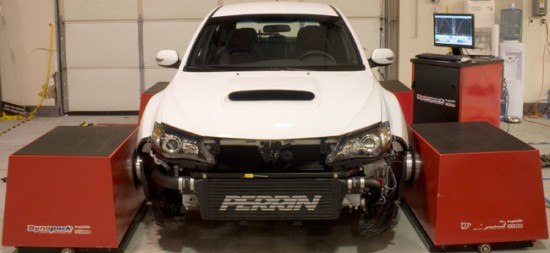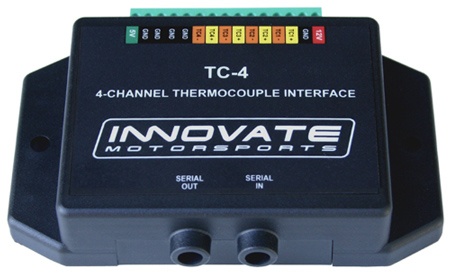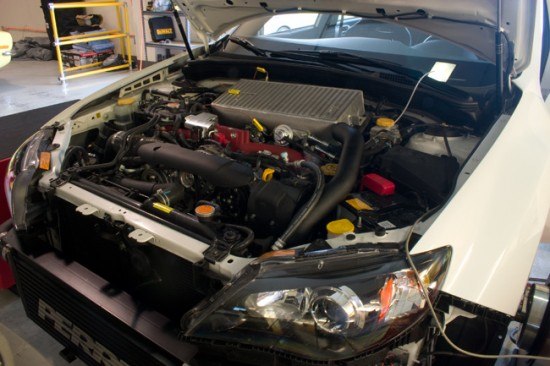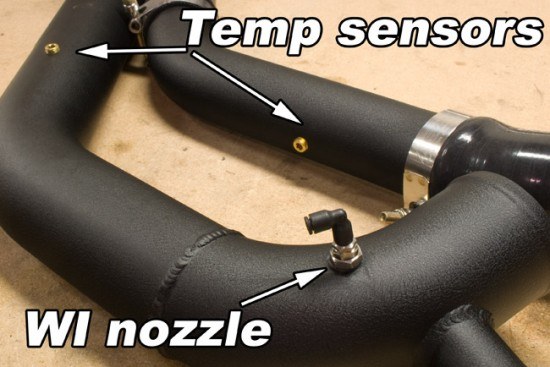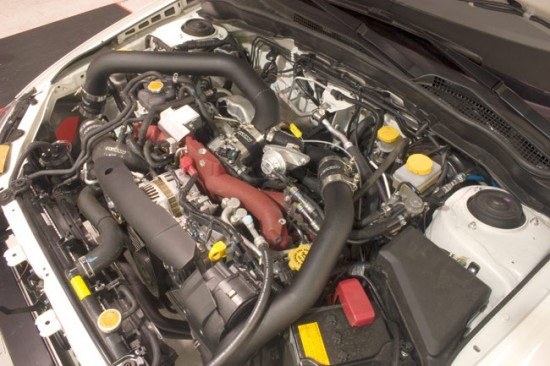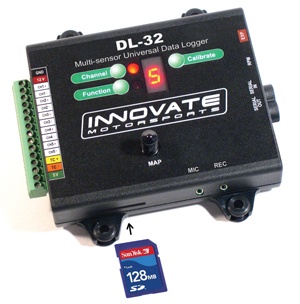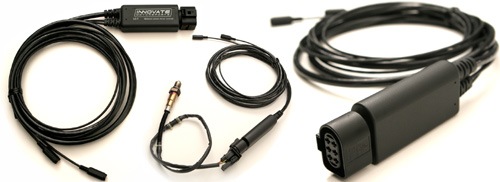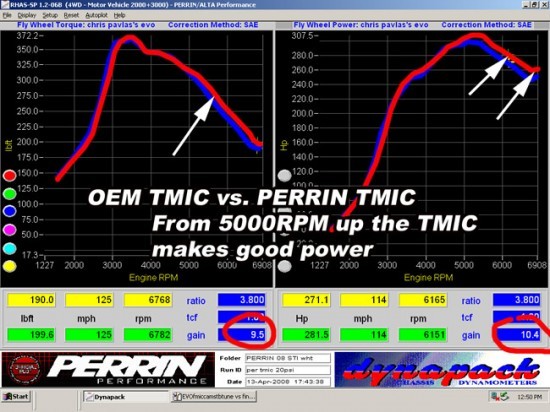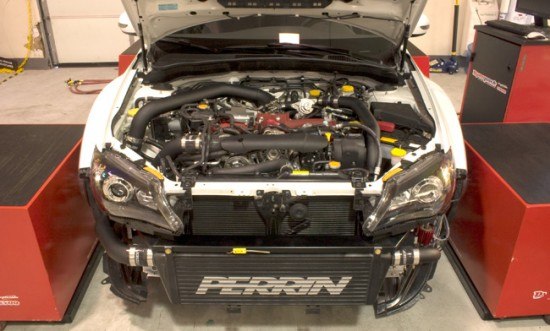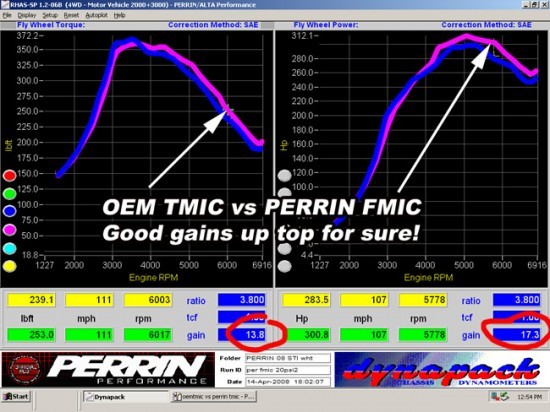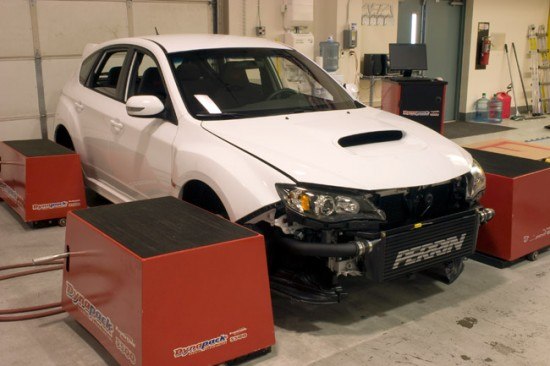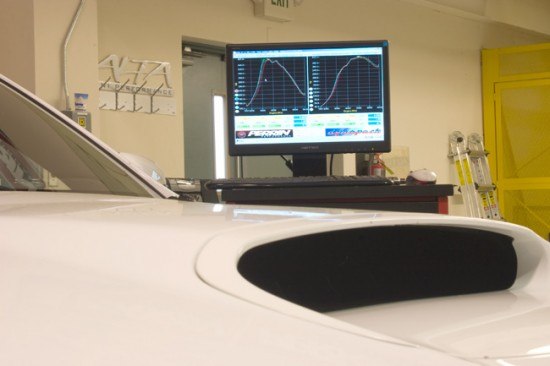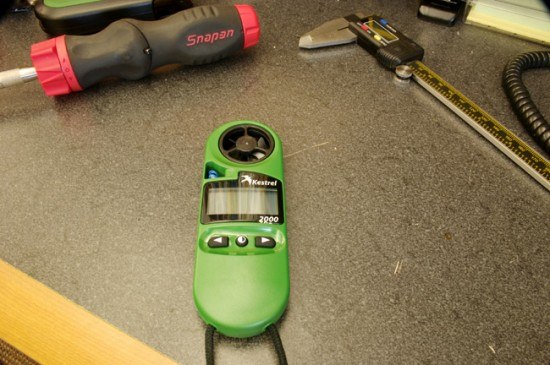Share This
The Great Subaru Intercooler Test
It's intercooler testing time. After a semi-cold winter, it was a great time to do some long awaited intercooler testing. Because our 08 STI has become the mule for testing of other parts, it's great for testing intercoolers. We have great results from previous dyno runs to back up the consistency of the power (or lack thereof with stock intercooler). Like other dyno sessions, we started with the same map and same dyno setup, and did a few base runs to see where we started.
Our last session we ended with our Stage 2 setup but with the Turbo inlet hose and intake system installed. Between then and now, we have added headers and no ECU tuning. For this test we will continue without tuning the ECU. This keeps more things consistent and shows the real world results from just bolting on parts. After the intercooler test is over, an ECU retune will be done for our future Stage 3 setup.
The Hardware That Makes This Test Legit
We have been using Innovate Products for a while now and like a lot of our other testing, we continue to support and utilize their superior products. The DL-32, TC4, and LC-1 are the 3 items we use to capture the data that you see below.
We use the TC-4 as our thermocoupler central hub. This unit takes up to 4 thermocouples and converts the signals into data so the DL-32 can read them. The 4 channels are taken up with EGT, Pre IC temp, Post IC temp and Ambient temp. On the TMIC we drilled and tapped them into the endtanks of both the OEM intercooler and the PERRIN. In an effort to keep them both reading the same temps, they were both installed in the same places on the tanks. The Ambient temp probe was stuck to the face of the intercoolers.The TMIC had the probe mounted about 3/8" off the core and the FMIC had it mounted on the bumper beam.
On the FMIC the pre- and post-temp sensors were mounted in the boost tubes right after the turbo and just before the throttle body. While these are not exactly the same placement we had on the TMIC setups, it would still provide accurate data.
Here is a shot of all the probes mounted and hidden on the FMIC setup. The probes were permanently installed with the FMIC in place so it was important to make it look nice and tidy.
The DL-32 is a Data Logging system that can read and log up to 32 channels of data. It has on-board logging capabilities using an SD card which is very handy for road/track tuning. This unit itself logs boost, temperature, RPM, and a few other 0-5 volt signals with lateral G and accel G sensor. The TC-4 thermocoupler module plugs into the "IN" serial port along with the Wideband 02 sensor.
Last but not least is the single most important tuning tool, the LC-1. This is Innovates newest wideband 02 sensor which is an all inclusive cable/wideband module, and sensor. As you see its in nice compact package that doesn't require boxes, or special mounting. Just power and ground and you're off! All of these systems tie together with serial type system. With all of them strung together, the final part of the string connects to a PC or gauge, or both! This allows the use of the Innovate Logging software on the PC to be used and collect all this data at high speeds, or allow for a string of gauges to be connected to it.
Once setup, the Innovate stuff is pretty cool and can provide a very clear picture of what is going on in your engine. Below is an example of the data we gathered. In the graph below, the data can be plotted against a custom built map. This is very useful when mapping an ECU.
Before we show our data, some important notes about the dyno and how we use it. The fans we were using is a constant velocity type; this doesn't replicate real wind speed that you would see on the road, but it does provide a constant airflow. All the intercoolers will function better on the road compared to the dyno. The differences in how intercoolers work or cool the charge will still be seen with these consistent parameters. On that note, both top mounted intercoolers were tested using the hood closed and using the OEM seal to direct the air through the intercooler. This provides as close to a real world result as possible with our fans. Some people put the fan directly on the intercooler, and while this does work, it makes for almost too much airflow at lower RPMs. Then out on the road (at lower RPMs) the car may not run as well as it did on the dyno.
Ambient temperature for the day was varying depending on if we look at the ambient temperature probe or the actual temp. The outside temperature of the car was 65F according to the outside temperature gauge. Also since there was no tuning done since the last Test and Tune, and there was now a header installed. The AFR's were slightly richer. With that said there were still very good gains from the header (roughly 10-15WHP), then being able to lean out the AFR's would net even more power, but this wouldn't be done until after the intercooler test was complete.
Leaks, yes sometimes we leak.....
We experienced a pretty large leak as the boost tube on the PERRIN TMIC slipped off the turbo a few times (due to a second, and oily Y pipe) and it is amazing how much this makes a difference in power and temps. The obvious thought is power because of the loss of boost. But there wasn't much in the loss of boost at all. Because the ECU is always adjusting for boost by keeping the wastegate closed, we didn't really see much change at all until above 6000RPM. Where we did see change, was in temperatures. We saw turbo outlet temps go up 25+ degrees F and intercooler outlet temps almost as much. This 25 degrees F is where we lost power. 25 degrees F hotter air mean less dense air, and less power. So why is this? Its pretty simple if you look at a compressor map for a turbo. If you plot airflow vs. boost, you will see that more boost or more airflow pushes the turbo efficiency way off the map. This means a less efficient turbo and bye bye power. Another effect on power is how rich the car runs with a leak. Richer AFRs occur because the ECU thinks there is air entering the engine and adds more fuel. The ECU doesn't know the air is escaping. Of course the size of the leak will depend on how rich the AFR gets, but either way it's bad. The richer AFR and the turbo being less efficient can cause significant losses in power.
One item people don't think about is the blow off valve. If this leaks, it's not as noticeable. On a Subaru, the BOV is vented back to the intake, so the car will at least not run richer, but the turbo efficiency comes into play, and again a loss in power. We are bringing this up because certain types of leaks may not be noticed on a boost gauge, and only seen on the dyno with a loss in power. It is always a good idea to check for boost leaks, or vacuum leaks in your boost system. This could be as simple as checking all the vacuum hoses to something a little more complicated like building a plug for the intake system and pressurizing the entire intake/boost tube system with compressed air. This will ensure your turbo is working properly, and you are not losing any power.
Onto The Test
Stock TMIC vs. PERRIN TMIC at ~17psi
First thing we noticed was the 15WHP changes were gone. Previously we would see pretty large HP swings when we would run the car quickly back-to-back. Now it would take about 5 runs before the HP really started to drop. This is a great first sign of a better intercooler. A couple other interesting notes, we saw roughly .5PSI more boost from 5000 to redline. This is an important thing to note as the stock STI turbo pretty much can't push more air than 14psi at redline. Adding more boost without changing the boost settings is also very good. The air temps were much more stable from run to run. If we compare the stock intercooler during the first few runs (while it's cool) the PERRIN TMIC outlet temps are very similar. Which means its efficiency is about the same. The turbo outlet charge temps were very similar but slightly higher. This could be because the turbo is flowing more air and the turbo is further out of its efficiency range. This shows that the PERRIN TMIC makes power by being less restrictive and more consistent.
Stock TMIC 17psi PERRIN TMIC 17psi
3000RPM Inlet 171F/ Outlet 97F Inlet 195F/ Outlet 107F
4500RPM Inlet 204F/ Outlet 102F Inlet 228F/ Outlet 119F
6900RPM Inlet 261F/ Outlet 138F Inlet 284F/ Outlet 158F
IC Efficiency 71%-63% at redline 69%-59% at redline.
The constant airflow from the fans, you can see that its not quite enough to cool the thicker core. On the road, the PERRIN intercooler will start to perform even better. Even with the lower efficiency, it made more boost at redline and it made more power from 5000 to the top.
Stock TMIC 20psi vs PERRIN TMIC at 20psi
With the Stock TMIC pushed to 20psi, we started to see where it really stopped working. Because the Turbo is running more boost, and is running out of its efficiency range, higher pre-intercooler temps were expected. This is also where the stock intercooler started to show its heat soaking issue. Both intercoolers were very similar on the first run, but the stock intercooler run after run would heat up a bit. Both intercoolers from about 6000RPM and up ran very similar in efficiency, but at lower RPM's the PERRIN TMIC was more efficient. The charge temps were a little cooler, the EGT's were 50F cooler, and overall the power was a little higher. The above graph shows the HP gained over stock, which is still very good.
The pressure drop difference from stock to the PERRIN TMIC got larger with the higher boost. Especially in the areas where the turbo really starts to kick. 1psi-1.5psi more boost was seen at lower RPMs with the PERRIN TMIC. At lower RPM this results in a steeper sharper boost curve. At 20psi the PERRIN TMIC was good for a few more HP and still that consistency, but not much cooler temps.
This is the intercooler that we had a leak issue with. With the leaks present, we saw an averaged loss in roughly 30WHP, and air temps were about 20 degrees higher, and 1.0-1.5AFR richer. This turned into a 40WHP loss at redline, and that was running the same boost!
Stock TMIC vs PERRIN FMIC at 20psi
This is where we see what an intercooler is good for! We did both 17psi and 20psi of peak boost, but 20psi is what the intercooler was made for! The stock TMIC and PERRIN TMIC work great for certain situations, but neither cool the charged air as well as an intercooler "could." This is where a front mounted intercooler comes into play. Having the intercooler on the front of the car is the most obvious place to put an intercooler. So why didn't Subaru put it there? Lots of reasons (not that I agree with all of them), packaging, installation, costs, responsiveness, insurance claims and not to mention the use of that signature scoop!
All the TMICs would see hotter and hotter temps as the runs continued, meaning that if the intercooler outlet temp peaked at 140F on the first run, by the 3rd or 4th run, it would be 150F and so on and so forth. While our TMIC was still better than stock in this situation, it still had room for improvement. There is just not enough ambient airflow for TMICs to work properly under heavy load. With the PERRIN FMIC installed, we would see intercooler outlet temps peak to 105F and by the 4th run it would peak to 110F. Yes, the highest intercooler outlet temperature we saw was 111F, this is compared to 158F we saw with the PERRIN TMIC. The below data is taken from the 3rd run of both intercoolers with roughly the same time between runs.
Stock TMIC 17psi PERRIN FMIC 17psi
3000RPM Inlet 171F/ Outlet 97F Inlet 197F/ Outlet 92F
4500RPM Inlet 204F/ Outlet 102F Inlet 248F/ Outlet 91F
6900RPM Inlet 261F/ Outlet 138F Inlet 300F/ Outlet 99F
IC Efficiency 71%-63% at redline 80%-86% at redline.
At these lower boost levels, the turbo works perfect and has no issues keeping up with extra plumbing.
Stock TMIC 20psi PERRIN FMIC 20psi
3000RPM Inlet 218F/ Outlet 110F Inlet 213F/ Outlet 103F
4500RPM Inlet 245F/ Outlet 113F Inlet 274F/ Outlet 103F
6900RPM Inlet 289F/ Outlet 149F Inlet 314F/ Outlet 107F
IC Efficiency 72%-63% at redline 75%-84% at redline
Intercooler efficiency on the stock TMIC changes (compared to the 17psi runs) because the intercooler gets more and more restrictive as airflow goes up, and in turn, needs more ambient airflow to cool it off. With our constant velocity fans, this doesn't happen. But if you look at our FMIC, the efficiency goes up! This is due to the intercooler being bigger and capturing more the ambient airflow, which then ends up cooling the air better. Remember this is with some simple fans, which do not represent the same type of airflow you see on the road.
So what is the downfall to the PERRIN FMIC? A very slight loss in response. The "fill time" is just barely noticeable compared to the TMIC. Again the intercooler inlet temps were higher on the FMIC as it was flowing more air, putting the turbo further out of its efficiency range. While this might be the case, it still made more power. Besides seeing the turbo outlet temps higher than on other runs, the boost was also a little lower (but not more than .5psi) so after a retune, there will be much more than 17WHP and 13 ft-lbs of torque.
Conclusion
The Stock TMIC is ok, for a stock car running stock boost, but when pushed, it started to show its faults. Not much else to say there!
The PERRIN TMIC is better than the stock intercooler. It does make more HP than stock and makes more boost efficiently. But overall the TMIC still has cooling issues, because of where it is placed in the engine and because of the rather small opening for air to reach it. Because the TMIC is not restrictive, and has some issues with cooling, this makes for a perfect intercooler when using water injection. Our PWI-1 can turn the PERRIN TMIC into a great intercooler for super responsive autocross guys that can use water injection. But for those who can't, the FMIC stomps the competition!
The PERRIN FMIC is so much better in all aspects. Cools better, no loss in overall boost, looks sweet on the car, perfect ambient airflow, more consistent power, more torque, etc. The only bad things are cost and install time. This can add an easy $1000 to the overall cost which is a huge factor when it comes to modding your car. If you are in a hot climate especially one with 91 octane fuel, or want the most from your Subaru, this is a must!
While this test was done on our 08 STI the same results will be seen on other vehicles. While road speed and ambient temps will vary from car to car and climate to climate, the deltas from before and after we found should be expected. Also the data we got from the Innovate Logging system is very clear and very fast and for anyone looking to gather accurate data at a reasonable price look to Innovate Motorsports for you needs. All of our shop cars are outfitted with their logging systems and wideband 02 sensors which are a great and necessary item for doing tests like these.
See? We told you our FMIC is for more than just looks! Look for future tests we do proving more PERRIN parts! We have lots of parts and lots of parts to prove. Next time, we will be putting that Water Injection nozzle to the test!



